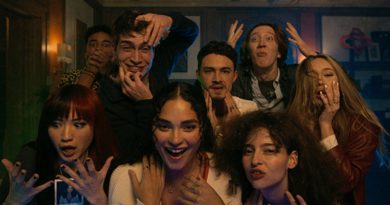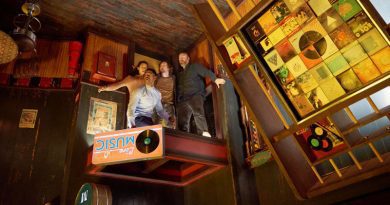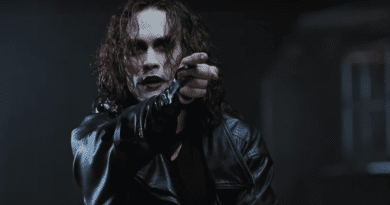Joker: Folie à Deux (2024) Review: A Mundane, Low-Stakes Sequel That Tries to Blend Musical Romance and Courtroom Drama
At one point during the trial in Joker: Folie à Deux, Arthur Fleck (Joaquin Phoenix) turns his back to Lee Quinzel (Lady Gaga) and cups his hand over his mouth to show how bored he is with a yawning gesture. That’s exactly how I felt watching this overly self-indulgent US$200 million (!) sequel, which cost nearly four times more than the first movie.
Speaking of the first movie, nobody could have guessed Todd Phillips’ gritty re-imagining of the famous villain from the Batman Rogues Gallery heavily indebted to Scorsese’s Taxi Driver and The King of Comedy would end up in the billion-dollar club. But it did as Joker became the highest-grossing R-rated film of all time until a certain superhero movie Deadpool & Wolverine dethroned that honour this year. The first movie even earned a whopping 11 Oscar nominations including Best Picture and took home two awards, notably Joaquin Phoenix for Best Actor.
Five years have passed ever since Joker made history for a movie inspired by a comic-book character. The much-anticipated Joker: Folie à Deux (pronounced as “fo-lee-uh-doo“), however, tells a different story altogether. It already got off to a divisive start when it opened to mixed reviews at the Venice International Film Festival earlier last month. And after finally watching it, I can’t believe how the quality has diminished significantly from the first movie as if a sudden split personality took over Todd Phillips’ mind, body and soul and came up with a middle finger of a sequel. It’s not like the sequel lacks trying such as the opening Looney Tunes-style animated sequence detailing Arthur and his shadow.
And yet, it feels oddly disconnected like a random experiment thrown in to see if it works. The experiment continues with half of the sequel taking place in the Arkham State Hospital, where Arthur remains confined there while awaiting trial for the five murders, one of which involves blowing talk show host and comedian Murray’s (Robert De Niro) brain out on a live television broadcast. One day, while being escorted by the wardens led by Jackie Sullivan (Brendan Gleeson in a solid supporting turn) to the next block in the minimum security ward, he meets a fellow inmate named Lee Quinzel.
Jackie subsequently enrols Arthur to a music therapy class due to his good behaviour and sparks fly between Arthur and Lee. She confesses that she has seen the TV movie modelled after Arthur’s Joker personality many times and is a big fan of what he did. They soon fall for each other and Phillips uses the jukebox musical approach to imagine the romance between Arthur and Lee as they would sing and/or dance on and off. The musical numbers are not only meant to express their wonderful time together but also depict Arthur’s state of mind and inner thoughts.
Frankly, I wish Phillips would do away with the jukebox musical because it barely resonates, let alone entertains with the choreography that feels lacklustre. Phoenix can sing, as proven in his role as Johnny Cash in Walk the Line but the feeling isn’t just there. It’s all sound coming out from his mouth but hollow on the inside. I hate to say this but the same also goes for Lady Gaga, who may have been a versatile singer who can transcend different genres of music. But her musical performance in Joker: Folie à Deux surprisingly falls flat, even though she did try her best playing the manipulative Lee Quinzel as an actress.
The sequel also introduces Maryanne Stewart (Catherine Keener), a defence lawyer representing Arthur determined to prove his crimes result from an abusive childhood and a split personality between Arthur Fleck and his Joker persona. She demands that he needs psychiatric help, unlike the opposing district attorney Harvey Dent (Harry Lawtey) aiming for the death sentence. This leads to the extended courtroom drama but instead of tense verbal face-offs, it just flatlines for most of the movie with a glacial pace. It sure feels like it’s taking an eternity for the trial to reach the verdict and even though there’s a glimmer of hope when Arthur finally shows up in the courtroom in a full Joker mode, it doesn’t take long before the movie falls back to its slumber mode.
Another huge problem in Joker: Folie à Deux is how small it feels due to the inherent stubbornness of confining itself within the Arkham State Hospital and the courtroom. The stakes are incredibly lower than I imagined, especially after what Arthur/Joker did during the third act of the first movie. Sure, it does contain a jolt of a scene, leading to a technically impressive continuous long-take moment. The movie also deserves mention for Lawrence Sher’s cinematography and Mark Friedberg’s production design capturing the sense of hopelessness regardless of the gloomy interiors of the Arkham State Hospital and the outdoors of New York-inspired fictional Gotham City.
But the results aren’t enough to justify how mundane this sequel turns out to be. No doubt that Phoenix gives his all, at least physically speaking from the way he looks all gaunt with skin and bones. Except for his overall performance that made him such a compelling character in the first movie is now reduced to a former shadow of himself. By the time the movie slogs to the bleak but sadly underwhelming finale, this laborious 138-minute Joker: Folie à Deux disappoints me as one of the worst movies I have come across this year.





